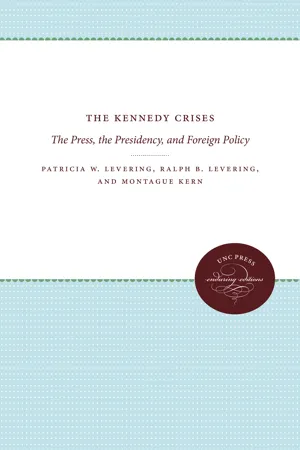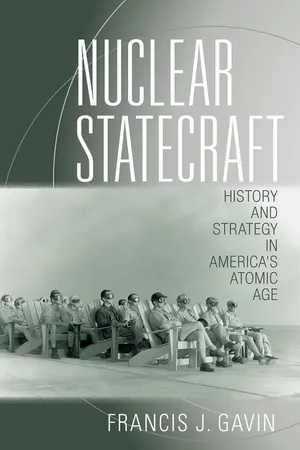History
The Berlin crisis
The Berlin Crisis refers to the period of heightened tension between the Western powers and the Soviet Union over the status of Berlin, Germany, from 1958 to 1961. The crisis culminated in the construction of the Berlin Wall, which physically divided the city and symbolized the broader division between East and West during the Cold War.
Written by Perlego with AI-assistance
Related key terms
7 Key excerpts on "The Berlin crisis"
- eBook - ePub
The Kennedy Crises
The Press, the Presidency, and Foreign Policy
- Patricia W. Levering, Ralph B. Levering, Montague Kern(Authors)
- 2018(Publication Date)
- The University of North Carolina Press(Publisher)
Part Three
The Berlin crisis of 1961
From its inception, the Berlin issue involved a direct confrontation between the superpowers. During the summer of 1961, the issue was whether Soviet Premier Nikita Khrushchev could change the status of East Berlin, which technically was governed by the four powers under an agreement negotiated after Germany’s defeat in World War II. The four powers were the United States, Russia, France, and Britain. The East Germans were not pleased with this arrangement because it left an enclave of free enterprise and propaganda right in the middle of their territory.It had not been intended that a peace treaty would never be signed ending this postwar arrangement, the Soviets and East Germans argued. But the West Germans strongly opposed the signing of such a treaty, for their policy called for the reunification of Germany. The United States had worked to build West Germany into an anchor of the Western alliance and supported the West Germans: there should be no peace treaty because it would involve acceptance of the communist government and negotiations on such issues as access rights with East Germany. The United States and the West Germans led the Allied effort after World War II to maintain the status quo, backed by the similarly hard-line French. The British, uncertain about the consequences of a reunited Germany, wavered, but supported their more hard-line Allies on critical issues. The East Germans were in a quandary. For them, a free city in West Berlin meant the loss of their citizens in increasing numbers through the open borders into West Berlin and along the access routes into West Germany. By the late fifties, they were suffering a considerable population loss among their most talented citizens, thus exacerbating their growing economic difficulties.Khrushchev had raised the issue of a peace treaty with Eisenhower. Indeed, he had presented him with an ultimatum on the issue in 1958. The president had met with Khrushchev and discussions had begun, but these were aborted as a result of the U-2 incident of 1960. The Berlin issue was also complicated because for years there had been an emotional defense of the status quo on the part of U.S. politicians and government officials. It was also complicated by the fact that Soviet efforts to support the East Germans had taken a form that Americans and West Germans had interpreted as a Soviet threat. The Berlin airlift of 1948, for example, was hallowed in memory as a heroic American effort to keep the brave West Berliners from being sucked into the yawning jaws of the communist monolith. Russia’s suppression of freedom in its satellite countries in Eastern Europe had enhanced this impression. Applying the “lesson” of Munich that any evidence of weakness could invite miscalculation or conquest, the U.S. foreign policy establishment proudly had defended the status quo in Berlin since the end of World War II. - eBook - ePub
After Sputnik
America, the World, and Cold War Conflicts
- Alan J. Levine(Author)
- 2017(Publication Date)
- Routledge(Publisher)
p.140 8 The Berlin crisisThe Taiwan Strait crisis had hardly subsided when the Western powers, not just the United States, faced the most serious crisis of all—one that sputtered on from 1958 to 1962, the crisis over the Soviet threat to West Berlin. Although it has not been much noted, the Soviet push against Berlin, in 1958, and 1961, was accompanied by efforts to cut down on the autonomy of Finland, crises the worried Finns called “night frosts.”In the clash over Berlin, basic interests of both sides would be in direct collision: the Western powers need to hold on to their position in Berlin, versus the Soviet desire to preserve their East German satellite—and, if possible, split and damage the NATO alliance beyond repair.West Berlin was another exposed outpost established early in the Cold War—during World War II, in fact—but was vastly more important than the Chinese offshore islands. p.141If proof were needed that the responsible leaders on the Western side had not envisaged the Cold War, the arrangements for the occupation of Germany, tentatively laid out in early 1944 and finalized at Yalta (when Stalin graciously allowed the Americans and the British to allot parts of their occupation zones to the French) would be proof enough. When the occupation zones were laid out, the German capital was left 110 miles inside the Soviet Zone, and cut into occupation sectors itself. The Western occupiers in Berlin were thus vulnerable to being cut off from ground access, at least, any time the Soviets cared to do so. Stalin exploited that vulnerability in the blockade of 1948–1949, to try to get the Western powers to drop their plans for western Germany, the Soviets halted rail, road, and water transport from the Western zones to the city. (Contrary to what is still widely assumed, getting the West to abandon its part of Berlin was a secondary, fallback position. Stalin, at first, was actually after bigger game.) The Western powers defied the Soviets, going ahead with their plans for a West German government and German participation in the Marshall Plan. They defeated the blockade by the great airlift, which, contrary to what they themselves had expected, flew in enough food and fuel to keep the city going indefinitely. (Originally they had hoped only that the airlift would win time and only delay the city being starved out, during which something might turn up.) The Soviets could not interfere seriously with the airlift—they did harass it—without shooting down Western planes and seriously risking war. And the West imposed a “counterblockade,” sharply restricting trade between their occupation zones and the Soviet Zone, making the crisis costly to the Soviets as well; with failure visible and costs mounting, Stalin gave up the blockade as a bad job. It had, in fact, backfired badly, angering public opinion in the West and cementing friendlier relations between the Western occupiers and the Germans. - eBook - ePub
The Bomb
Presidents, Generals, and the Secret History of Nuclear War
- Fred Kaplan(Author)
- 2020(Publication Date)
- Simon & Schuster(Publisher)
HAPTER 3 The CrisesT he Berlin crisis began before John Kennedy took office. On January 6, two weeks prior to the inauguration, Soviet premier Nikita Khrushchev delivered a speech to Moscow’s leading ideological institutes, vowing that the policy of “peaceful coexistence,” which he had forged with President Eisenhower, would not interfere with the political and economic struggles between East and West. Much of the speech focused on the “wars of national liberation,” which he affirmed were “sacred,” to be supported by Communists “wholeheartedly and without reservation.” It was these passages that triggered Kennedy’s keen interest in counterinsurgency operations. But there was another section of the speech that stirred deeper alarm: Khrushchev’s threat to annex the city of West Berlin.Berlin had been the centerpiece of struggle throughout the Cold War. It was where the Second World War ended, the Allied armies meshing into one another as they occupied Nazi Germany—the United States, Britain, and France from the west, the Soviet Union from the east, carving out the separate zones of West and East Berlin. Soon after, Germany itself would split into East and West, and the border between the two hardened into the dividing line between Soviet-controlled Eastern Europe and a democratic capitalist Western Europe. West Berlin emerged as an anomaly—a tiny landlocked island, stuck a hundred miles inside East German territory but claimed and protected by the Western powers. In 1948, Josef Stalin imposed a blockade, cutting Berlin off from its Western suppliers. The United States responded with an airlift (managed by Curtis LeMay, who was commander of U.S. Air Force Europe, the success of which spurred his promotion to run SAC), keeping the zone supplied for eighteen months—at its peak, 500 flights a day, bringing in 1.5 million tons of food, coal, and medical supplies—before access was formally restored. Ten years later, Khrushchev again threatened to place West Berlin under East German sovereignty—an act that he characterized as ending World War II—but backed off after a harmonious meeting at Camp David with President Eisenhower. - eBook - ePub
Nuclear Statecraft
History and Strategy in America's Atomic Age
- Francis J. Gavin(Author)
- 2012(Publication Date)
- Cornell University Press(Publisher)
In November 1958, Soviet premier Nikita Khrushchev demanded that Western soldiers leave Berlin and that access to the city be controlled by East Germany. Scholars have identified several important motives for Khrushchev’s ultimatum. Two stand out: First, Berlin’s status allowed dissatisfied citizens of the Eastern bloc and particularly East Germany to leave for the West. Both the sheer numbers and the high quality of those leaving threatened to undermine the German Democratic Republic. 17 Another, perhaps even more compelling, motive was to signal the Soviet Union’s great concern and displeasure over what appeared to be the nuclearization of the Bundeswehr, West Germany’s army. 18 This crisis lasted for four years with several key phases. 19 The first took place at the end of the Eisenhower administration and saw both threats as well as attempts at negotiation. The second took place between the spring and fall of the first year of the Kennedy administration. The final phase took place the next year and culminated with the October 1962 Cuban missile crisis. Many of the issues animating the crisis over Berlin were de facto resolved in negotiations between the Soviet Union and the United States in the summer of 1963, although the de jure resolution of the situation did not come until the quadripartite agreements of 1971. 20 Were the issues separating the Soviets and Americans vis-à-vis Berlin between 1958 and 1962 intractable? And, in particular, did the Americans have no “give” in their position? Did they find the status quo ideal and have no regard at all for the views of the Soviet Union? Given the length and severity of the crisis, one might have expected US policymakers to dig in their heels, ready to maintain their position at all costs. In the prenuclear age, such circumstances made for the most dangerous crises. But that was not the case with US policy toward Berlin - eBook - ePub
- Dale C. Copeland(Author)
- 2013(Publication Date)
- Cornell University Press(Publisher)
18Until even mid-1947, declassified documents show that Moscow still preferred détente to all-out cold war. This hope was undermined by Washington’s announcement of the Marshall Plan to strengthen western Europe’s economy.19 The primary factor leading to The Berlin crisis was the London Conferences of January-March 1948, in which the United States, Britain, and France agreed to unite the German occupation zones and to hand political control over to an independent western German government.20 This act left the Soviets facing a rising West Germany tied to the western bloc, a daunting prospect for a nation that had just lost so many lives fighting Germany. Berlin was both a means and an end for Moscow. As a means, the Soviets saw pressure on Berlin, particularly the blockade, as a way to convince the west to reverse the London agreements. As an end, the Soviets, by terminating the western presence in Berlin, hoped to stop the flow of refugees from the Soviet zone that was weakening the eastern German economy.On 18 June, General Clay announced currency reform for the western zones, a first step in creating a unified West German state. The Soviets warned that they would act to protect their bloc’s economy; on 24 June they blockaded all ground traffic to West Berlin. Washington realized the impact of currency reforms on the faltering eastern German economy. Political Adviser for Germany Robert Murphy wrote to the secretary of state on 19 June that Soviet measures to restrict traffic were “not unreasonable [given] the natural defensive action to protect [the] Soviet zone.”21 On 24 June, eastern bloc foreign ministers released a statement on the London Conferences revealing the larger Soviet fear: a resurgent West Germany. Among the problems to be settled, the statement noted, were Germany’s demilitarization and control over heavy industry “with a view…to preventing the re-establishment of Germany’s war potential.”22 - eBook - ePub
- WILFRED LOTH(Author)
- 2004(Publication Date)
- Routledge(Publisher)
PART II: EUROPEAN REACTIONS TO THE BERLIN AND CUBAN CRISES, 1958–62Passage contains an image 3 Adenauer and Nuclear Deterrence
Klaus SchwabeIThe so-called ‘Khrushchev Ultimatum’ of November 1958 triggering the second Berlin crisis heralded one of the tensest phases of the Cold War in Europe. For the first time, it raised the spectre of a nuclear showdown in which the West no longer enjoyed an unquestioned superiority over the Soviet Union. This Soviet challenge tested first of all the credibility of the policies the Western powers so far had adhered to on the German and the Berlin questions. It tested the Cold War policies of the West by confronting its governments with a number of awkward questions: Were the three former Western occupation powers really resolved to insist on their rights in Berlin? Were they prepared to defend the political independence of the city’s population and its ties to the Federal Republic? Were they determined to uphold West Berlin’s position as the decisive gap in the Iron Curtain—an opening that permitted East Germans to flee to West Germany—created a continuous brain drain that undermined the GDR and, as the Bonn government claimed, thus preserved the chances of reunification? Were the Western powers resolved to risk a military or even nuclear showdown in order to defend all these various interests?The military option was a problem which the West German Chancellor Konrad Adenauer had to cope with as well. In reacting to The Berlin crisis, he appears from hindsight to have been an extreme type of cold warrior because he risked nuclear war rather than consider yielding an inch to Soviet pressure, refusing to make any concessions whatsoever to ‘Russia’ by sticking to what he called a ‘policy of strength’. This course alone, he predicted, would ultimately lead to the collapse of the Soviet Union and would bring about realistic chances of German unification. A closer look, however, reveals that Adenauer was not quite the ‘iron chancellor’ that some admirers (and critics) wanted him to be. To demonstrate this we will cite two examples: the way he reacted to The Berlin crisis and, more generally, the attitude he adopted toward NATO’s nuclear strategy in The Berlin crisis. - eBook - ePub
Driving the Soviets up the Wall
Soviet-East German Relations, 1953-1961
- Hope Harrison(Author)
- 2011(Publication Date)
- Princeton University Press(Publisher)
CHAPTER THREE
1958–1960
Khrushchev Takes on the West in The Berlin crisis
A BOLD INITIATIVE by Khrushchev and the reaction it provoked again takes center stage in this chapter. Yet Khrushchev’s initiation of The Berlin crisis was very different from his de-Stalinization campaign and emphasis on peaceful coexistence at the Twentieth Congress described in the previous chapter. Khrushchev’s accommodating style toward the West became coercive in the fall of 1958. How and why did Khrushchev change his approach, and why did he decide to focus his foreign policy on Berlin and Germany? What was the role of Ulbricht in the crisis? This chapter and the next will examine these questions. The present chapter traces the process leading to Khrushchev’s 10 November speech and 27 November ultimatum, which launched The Berlin crisis. It then follows the development of the crisis through the summer of 1960 and the aborted Four Power Paris summit, after which Khrushchev decided to wait to negotiate with the next U.S. President, John F. Kennedy. Chapter 4 examines the final year of The Berlin crisis climaxing with the building of the Berlin Wall.Between 1953 and 1958, the Soviets treated the question of East German policies and the stability of the SED regime largely as an internal matter of the GDR and the Soviet Union. The Kremlin leaders hoped that a combination of moderate East German policies and Soviet aid would stem the refugee flow and solidify their German ally. During The Berlin crisis, however, Khrushchev attempted to involve the West in the matter of the stabilization of the GDR. He anticipated that Western recognition of the SED regime and a reduced or eliminated Western presence in West Berlin would significantly alleviate the pressure on East Germany and put it on solid ground.For key parts of this chapter, the West replaces Ulbricht as Khrushchev’s key interlocutor, but Ulbricht returns in a key role in the next chapter. Unlike Chapters 1 and 2
Learn about this page
Index pages curate the most relevant extracts from our library of academic textbooks. They’ve been created using an in-house natural language model (NLM), each adding context and meaning to key research topics.






